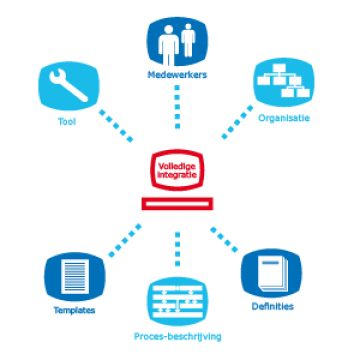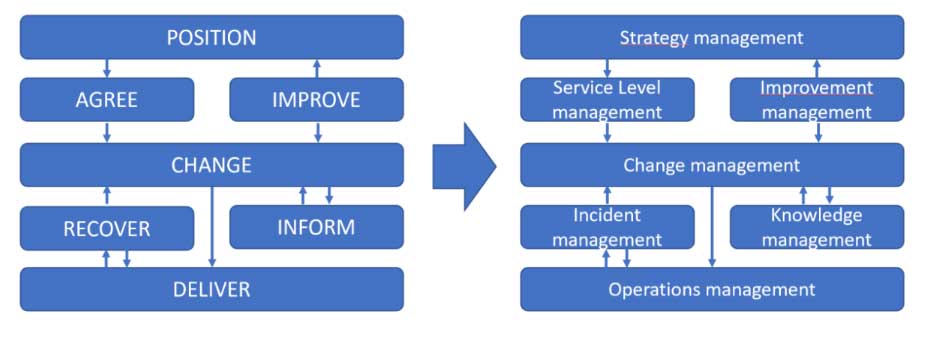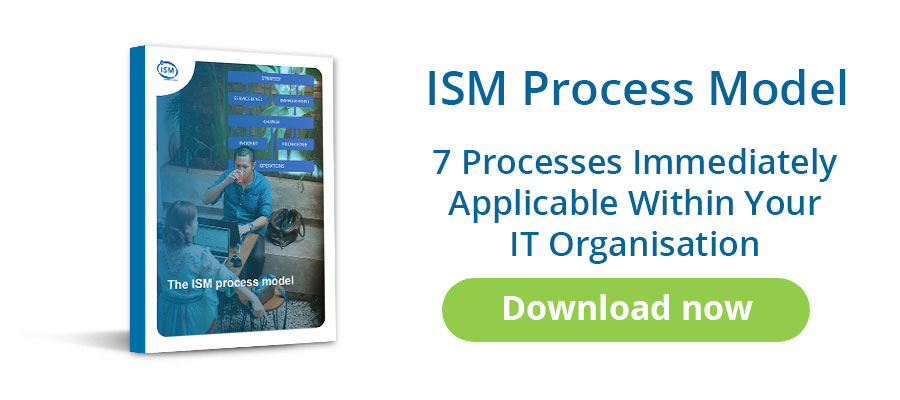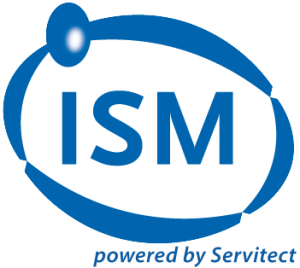What is ISM?
As an IT organization, you want to deliver the IT services that your customer needs, and preferably in a safeguarded and efficient manner. The Integrated Service Management Method, or the ISM method, offers a complete and compact solution for IT organizations that want to collaborate better and demonstrably deliver added value to their customers.
Focus on customer value
Working method and performance in control.
Space for the professional.
What is ISM?
Integrated Service Management (ISM) is a popular and proven standardized management method that optimally organizes your IT service delivery and IT service management. It is a complete and at the same time compact set of processes, roles, procedures, tools, and work instructions to design, deliver, manage, and continuously improve all IT services. ISM ensures that all the resources that the IT department employs – People, Process, and Product – are organized and managed in conjunction.
With the ISM method, your organization gets full control over IT service delivery. It not only organizes all work processes and collaboration agreements, but you are also assured of an agile and lean working method. Furthermore, ISM ensures that you can meet the requirements in terms of compliance and security. And all of this in an effective and relatively simple way.
The goal of ISM is to create customer value. Therefore, the ISM method places humans at the center: the professional who creates the services, the leader who facilitates, the client who determines the service, and the end user who uses IT to improve their work.
With ISM, more control over your working method
Are one or more of the following issues recognizable for your IT organization? Then ISM can also be the solution for your organization to gain more control over the working method.
- People are working too much on their own islands.
- Incidents, service requests, changes, and projects are not handled uniformly.
- There is insufficient focus on innovation and improvement of IT services.
- Customer satisfaction lags behind, SLA agreements are not met, projects are delayed…
- There is insufficient insight into performance, and reporting on quality is challenging.
- It’s not possible to demonstrably meet compliance and security requirements.
- Employees are drowning in various complex processes and working methods.
- Process descriptions are incomplete and/or poorly maintained.
Challenges in the IT department can always be traced back to unclear goals and the way the work is organized. Often, a clear, uniform, and integral working method is lacking, causing the IT system to not function optimally. This unnecessarily costs a lot of time and manpower. You also constantly need ad hoc measures to address structural errors. And all of this comes at the expense of customer service, management focus, and employee motivation.
Improved collaboration thanks to ISM
The ISM method enables everyone – administrators, IT managers, process managers, operational employees, clients, and end users – to collaborate like a well-oiled machine. In ISM, it’s not the technology that’s the starting point, but the collaboration in delivering IT services. ISM facilitates managers and professionals optimally, so that they can deliver excellent service to the business. Managers can focus on management, while employees focus on their core tasks. Resulting in: improved collaboration, better IT services, motivated employees, and satisfied customers.

What does the ISM method deliver?
The ISM method was developed for IT management organizations that want to standardize their way of working wherever possible in order to improve their IT service delivery. Organizations that have implemented the ISM method notice within three months that there is more calmness and coherence in the work. The organization operates better and becomes more flexible and agile. Our customers experience, among others, the following benefits:
- Control over the methods, processes, management, resources, and costs.
- In control due to up-to-date dashboards and clear reports.
- Uniformly established agreements, procedures, and work instructions.
- Clear role distribution, better management, and peace on the work floor.
- Faster and better handling of projects, changes, service requests, and incidents.
- Handlings demonstrably meet compliance and security requirements.
- Measurable improvement in the quality of IT service delivery.
- Higher customer satisfaction and an improved relationship with the client.
- IT service delivery that visibly contributes to the strategic organizational goals.
More than 100 organizations use the ISM model to guide their way of working!
The best of various management methods
Is ISM then another additional management method that you have to implement? No, quite the opposite! The strength is that ISM combines the best of various methods and approaches into one integral and practically applicable approach. So, ISM is a practical amalgamation and standardization of methods such as ITIL®, DevOps, BiSL, VerISM, and agile techniques like Lean, Kanban, and Scrum. Continually reinventing the wheel to implement one’s own processes and applications is thus a thing of the past. This way, you can finally focus on your core tasks.
The ISM model makes ITIL practical and applicable
Most organizations already work with ITIL. However, this is a reference model. Everyone can use these best practices to create their own application. But how to do that best is not clear. You will also have to adapt the tools to support the processes to your own processes.
On the other hand, the ISM model is a practical application model that simplifies ITIL and reduces it to its core. With that, ISM encapsulates twenty years of ITIL into a simple and workable solution. Moreover, the ISM model focuses on all so-called value streams: delivery, innovation, and optimization.
ISM particularly focuses on the human factor. A change in methodology primarily requires a change in people’s behavior. Therefore, ISM mainly focuses on the transformation that an organization undergoes.
The main features of ISM
The ISM method is characterized by several important features:
- Customer value: Everything in ISM is aimed at realizing customer value. Activities, resources, and people that do not deliver customer value are avoided.
- Holistic: A well-functioning IT organization must set up all organizational components at the operational, tactical, and strategic levels. Without clear objectives, professionals cannot function efficiently and independently.
- Integration: All present organizational components (People, Process, and Product) are aligned with each other and reinforce each other.
- Applicable: A methodology is only valuable if it can be applied well. Configurations that are too complex and contain too many processes will never function properly. Within ISM, there was therefore a conscious choice for concise and recognizable definitions, insightful dashboards, and a compact process model with no more than three value streams and seven processes.
- Standardization: All IT organizations aim to provide good IT services and customer value by making available current and well-functioning information systems. Because these goals are identical for all IT organizations, the methodology can also largely be standardized.
- Co-creation: Given the high dynamics and relevance of IT services to the customer, it is important that the customer is continuously actively involved in the creation of the IT services.
- Phasing: Organizations must be able to grow at their own pace, in line with their business objectives. The ISM method is universally applicable for every service organization, but supports the organization’s own growth path.
How is the ISM method structured?
The complete ISM method consists of several important pillars. Deze vormen samen het ISM-ecosysteem, een complete set van samenwerkende producten en diensten:
- ISM description
- ISM framework, including process model
- ISM implementations
- ISM support
ISM description
The ISM method is described herein. The ISM description consists of a collection of books, whitepapers, and articles that collectively explain the ideology and choices in a clear manner.
ISM framework
The framework forms the basis of the ISM method. In this ISM framework, all resources – People, Process, and Product – are available, elaborated, and integrated. It is a proven and simple standard setup of the methodology, where processes, process functions, and optimal setup of helpdesk tooling are fully aligned with each other. The ISM framework includes, among others, the ISM process model, setup of service desk tools, definitions and templates for work instructions, SLAs, dashboards, reports, and customer satisfaction surveys. This way, the framework ensures the straightforward implementation of ISM.

ISM process model
The core of the framework is the ISM process model With this ISM model, consisting of no more than seven clear processes derived from ITIL, a lean IT service management approach can be established. Implementing the ISM model is much simpler than interpreting and applying thirty ITIL best practices. ISM focuses primarily on improving collaboration, and the process model is therefore primarily a coherent set of collaboration agreements.
The seven ISM processes form the core of every IT organization:
- Positioning – Strategy Management (STM)
- Agreeing – Service Level Management (SLM)
- Preventing – Quality Management (QM)
- Changing – Change Management (CHM)
- Restoring – Incident Management (INC)
- Informing – Configuration Management (COM)
- Delivering – Operations Management (OPS)

These processes reinforce each other and describe all activities at the tactical and operational levels. This creates a comprehensive, but above all, a simple, applicable, and manageable approach.
ISM implementations
A good framework in itself is not a guarantee for success. That’s why the implementation or adoption is also part of the ISM method. Our ISM implementations are focused on introducing the framework and guiding your organization in the application of this framework and the cultural change required for it. In just three months, you implement the core of the framework and then learn to apply it. There is a lot of attention for individual choices and phasing, ensuring that the standard approach aligns optimally with your own organization.
ISM support
Support constitutes the fourth pillar of the ISM method. The ISM support tools can be used both during and after an ISM implementation. Consider:
- Education, training, and games.
- Compliance tool (ISO 27001, NEN 7510, or BIO)
- Audits and scans
- Management coaching
- Back-office support
- Knowledge exchange
Everything you need for excellent IT service management.
So, the complete ISM method consists of a wide range of coordinated services and products to work optimally with ISM. A successful application of ISM also requires careful implementation, continuous management and development, and user support. In the ISM method, all these aspects are present and aligned with each other. It provides everything you need for excellent IT service management!
Download the ISM process model
Do you want to further professionalize your IT management? With the free ISM process model, you can immediately, easily, and quickly implement, apply, and understand the ISM method: 70 pages directly applicable! Download the e-book below:
Frequently Asked Questions about ISM
How does ISM contribute to modern service management?
Modern IT management demands a lot. Technological advancements are progressing rapidly, organizations are increasingly reliant on IT, and regulations are becoming more complex. IT organizations must therefore meet changing business demands and stricter requirements in terms of compliance and security. And IT services must increasingly be flexible, efficient, and secured. To achieve that, good collaboration among all IT professionals is necessary.
A modern service organization succeeds in enabling everyone to collaborate professionally, ensuring that the customer – the business or end-user – receives the service they need. In such an organization, professionals are given the space to practice their profession in a professional manner. The management is in control, but doesn’t need to constantly monitor. The service delivery demonstrably meets the customer’s needs, including security and compliance requirements.
Unfortunately, we see that many IT departments are still struggling to take this step towards becoming a modern service organization. Thirty years of IT service management and twenty years of ITIL have yielded insufficient successful and lasting results. The solutions are too complex and consist of too many non-cohesive components, which are also poorly applied.
That can and should be different, which is why we have developed the ISM method. This allows collaboration and workflow to be simpler, more efficient, and more coherent.
Why was the ISM method developed?
We developed the ISM method because we believe that delivering good IT services can be easily achieved. However, many organizations fail to achieve that. An important prerequisite is that the management’s focus is shifted from technology and projects to the setup and management of the workflow. This is possible when the setup of IT management comprehensively organizes all the occurring tasks. With that goal in mind, the ISM method was designed.
The ISM method is the result of years of practical and theoretical development. It has been developed with the help of many IT organizations and specialists. They all indicated a need for clear, uniformly applied frameworks within which they can work freely. The ISM method fulfills that need.
Who is ISM intended for?
ISM is developed for IT organizations that aim to maximize the standardization of their processes to improve their IT service delivery and carry out successful operations. Both large and small IT organizations gain control over their service delivery with ISM. These can be organizations starting with process-oriented work or organizations that have already begun with ITIL but are not making sufficient progress. ISM is also highly suitable for organizations that want to demonstrate compliance with ISO 27000, BIO, or NEN 7510.
Is ISM only suitable for IT?
The ISM method is a universal approach and suitable for all departments that provide services to the organization. The ISM method is a universal approach and suitable for all departments that provide services to the organization. ISM is often used by IT departments, but the method is also applicable to other service-oriented organizations, such as facility management, medical technology, and real estate management. What makes ISM unique is that it offers a single integrated solution for the workflows of all service-oriented departments. This creates coherence and integration, and elevates all supporting departments to a higher level.
Which value streams does the ISM model organize?
With the six processes of the ISM model, you can fully cover all necessary value streams – delivery, innovation, and optimization. All activities that an IT management organization carries out fit into one of these three value streams:
- Delivery focuses on providing your IT services. This simply means ensuring that the information system is operational, providing the required support, and performing necessary recovery tasks when needed. This stream forms the basis of your service delivery to your customer, which is your customer value.
- Innovation is focused on renewing the services you offer. In IT, this is an essential component given the high speed at which technological advancements follow one another.
Optimization is necessary to remove errors and imperfections from your information system and workflow. By resolving these ‘technical debts’ and ‘organizational debts,’ you continuously improve the service provided to your customer. In a clean environment, delivery and innovation can take place much more effectively and efficiently. - The three value streams only flow smoothly when the resources of people, process, and product are adequately present and organized in coherence. Not only at the operational level but also at the tactical and strategic levels. And that’s achievable with the ISM model.
Why is a uniform and integrated approach so important?
Clear and uniform processes make the workflow more transparent and efficient. And this leads to greater trust from the entire organization, demonstrable compliance, increased control and oversight for management, fewer errors, and significant cost savings. In many of our clients, this uniform approach was lacking, causing people to work at cross-purposes, mistakes to occur, work handovers to be impractical, and everything taking up unnecessary amounts of time. For example, in the case of taking, assessing, processing, and documenting incidents.
IT often becomes unmanageable due to the simultaneous application of various management methods and practices alongside each other. This unnecessarily complicates the IT organization, causing managers and employees to be overwhelmed by various systems and processes. Only a uniform, integrated setup of the workflows within your IT organization leads to the optimal utilization of everyone’s capabilities. Managers can focus on management, while employees focus on their core tasks. As a result, the IT organization can deliver the services demanded by its customers.
A common mistake, for example, is to implement compliance, Agile, Lean, and DevOps separately instead of integrating them with each other. And that too, alongside an existing approach or as a partial replacement. Successful organizations, however, don’t do “both, this and that.” They integrate these methods optimally with their existing processes, creating only one integrated and customer-oriented approach.
Why is a standard ISM model suitable for every IT organization?
All IT organizations, large and small, profit or non-profit, share the same goal: delivering quality IT services at the lowest possible cost and in the shortest possible time. That’s why they can all apply the same standardized approach to organize their work. While the services and resources may vary, the internal approach and processes do not. This means that every IT organization can work with one standardized and well-proven solution like ISM. Wasting valuable time on custom setups and continuously adjusting processes and tooling is now a thing of the past.
There have been more than 100 successful ISM implementations so far. This proves that standardization is attainable for your organization as well.
What does standardization yield?
By using standardized processes that are already worked out, the need to describe processes from scratch is eliminated, which is a lengthy and costly endeavor. Moreover, standardized resources can also be set up in advance. There is no need to spend energy on the development of these resources anymore. This energy can be directed towards the real challenge, which is changing the working methods and culture of the IT service management organization.
The increasing use of standardized processes and associated tools leads to the accumulation of knowledge and experience. By collectively using these standardized processes, experiences and ideas become available more quickly, leading to better solutions. This leads to a wealth of user experience. And: products that are used more widely become cheaper. Organizations that choose this form of standardization gain access to solutions that are demonstrably effective. As a result, they can significantly improve their service delivery and save costs.
Since 2005, we have been consistently working on the further development of the ISM method, where this user experience leads to continuous improvement and innovation.
How does ISM help the IT administrator?
The ISM methodology provides the administrator with clear guidelines within which they can perform their work. The setup and management of the workflow are easily executable and controllable thanks to ISM. All the resources used by the administrator – People, Process, and Product – seamlessly align and reinforce each other. Thanks to the clearly defined authorities and responsibilities, the administrator has more freedom to practice their profession effectively and apply their specialized knowledge. The administrator also needs to spend less time on consultations. The IT administrator experiences an improved collaboration with colleagues almost immediately, as everyone consistently applies the new, streamlined approach. And thanks to focused registration, the IT administrator no longer needs to document more than necessary.
How does ISM help the IT manager?
Thanks to ISM, the IT manager gains quick insight and control over their organization. With the implementation of clear agreements and applicable tools, the IT manager needs to intervene operationally much less frequently. In addition, ISM leads to better (process) management reports, dashboards, and monitoring. The IT manager has steering information that allows him to make targeted adjustments and interventions. Through its own measurements, the IT manager gains more insight into the performance of suppliers and can manage them more tightly.
How does ISM help the process manager?
Thanks to the standards and various tools provided by the ISM method (such as process and role descriptions, reports, and templates), the process manager needs to invest less effort in process design and can instead focus on process control. The implementation of ISM also establishes the relationship with the process owners, allowing the process manager to receive support and authorization from the management team to carry out his duties. The process manager can therefore focus on supporting the administrators and the service delivery. This paves the way for servant leadership.
Download the ISM process model
Do you want to further professionalize your IT management? With the free ISM process model, you can immediately, easily, and quickly implement, apply, and understand the ISM method: 70 pages directly applicable! Download the e-book below. Also, check out our ISM services.


ISM Portal
Fokkerstraat 16
3833 LD Leusden
Athenestraat 12
9403 DX Assen
info@ismportal.nl
+3188 - 2034000